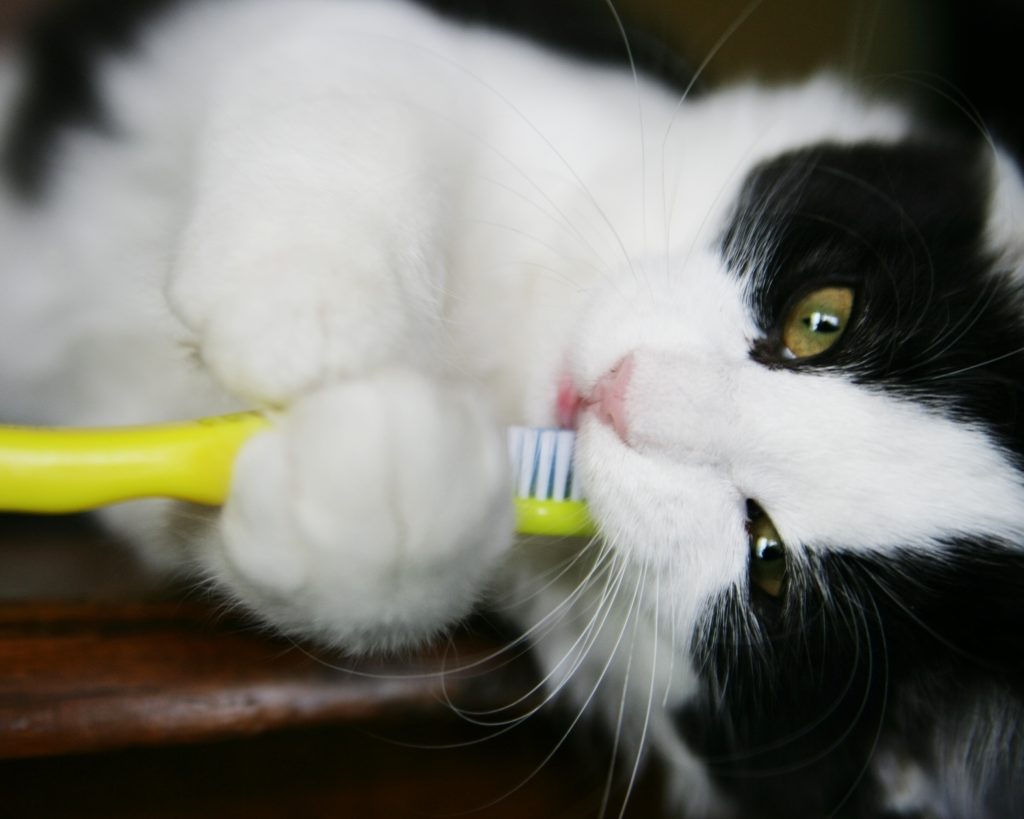Home Pet Dental Care: The Key to a Healthy Mouth

By age 3, up to 85 percent of pet dogs and cats exhibit some signs of periodontal disease. Untreated periodontal disease can spell big problems for a pet, including damage to the heart, kidneys, and other major organs, not to mention possible tooth loss and significant pain.
Anything a pet owner can do to reduce the amount of plaque and tartar buildup on their pets’ teeth will have a big impact on the overall health. Regular home pet dental care is key in keeping your pet’s pearly whites healthy. Good oral health can add years to a pet’s life, and can keep those years more comfortable.
The First Step
Can you imagine never, ever brushing your teeth? We certainly can’t, but for many pets this is a reality. Much like with humans, regular tooth brushing is the most effective means to maintain good oral health for your pet in between professional dental cleanings. Removing the plaque and tartar buildup that accumulates on the teeth is integral in preventing the onset of periodontal disease.
At Dupont, we believe in the “4 Pillars of Home Care”:
- The First Pillar: Pet Tooth Brushing
- The Second Pillar: Diet
- The Third Pillar: Chew Products
- The Fourth Pillar: Food Additive.
The First Pillar: Pet Tooth Brushing 101
Training of any kind tends to work best when a pet is young, and ideally, a pet would be introduced to tooth brushing as a puppy or kitten. If you’ve never wielded a toothbrush near your adult pet’s mouth, don’t despair. With practice and patience, even older dogs and cats can learn to accept regular tooth brushing.
Try the following tips for getting a pet used to tooth brushing:
- Week 1: Acquaint your pet with oral care by using your hand and gently life your pet’s lips and run your finger along the lips and teeth. Do this for about 30 seconds on the first day and gradually progress to about 2 minutes by the end of the week. It’s best to go slowly and use a lot of verbal praise to gain your pet’s confidence. Put a dab of pet-specific toothpaste (never use human-grade toothpaste as it may be toxic to pets) on your fingertip and offer it to your pet at the same time each day.
- Week 2: Introduce a cleaning device like a pet toothbrush or finger-tab brush with a soft bristle. You may want to add a small amount of peanut butter or canned food to enhance taste with the circular motions and brush onto the outer surfaces of the teeth.
- Week 3: After your pet has become accustomed to your finger, transition to offering pet toothpaste on a toothbrush, gently brushing over the outside of the teeth. We recommend an enzyme based, poultry flavored toothpaste called C.E.T. It’s best not to rush the process to avoid resistance and discomfort and ideally brushing 3 times a week is adequate.
Your veterinarian will be happy to demonstrate proper tooth brushing technique at your pet’s regularly scheduled wellness exam.
The Second Pillar: Diet
We recommend Hill’s Science Diet T/D prescription food for ideal dental care. T/D stands for Tarter Diet and the larger kibble size does not immediately shatter in your pet’s mouth, ensuring a longer chew and sloughing of tartar from the teeth. As your pet chews, the fiber matrix in the T/D diet gently scrubs the entire surface of each tooth removing plaque & tartar buildup. This prescription diet can be used as a stand-alone diet or can be added to your standard feeding habits.
The Third Pillar: Chew Products
We recommend one of three products for dogs that like to chew treats to give them a great, tasty activity while benefiting their oral health : OraVet Oral Chews ; CET (Enzyme Coated) Rawhide Chews ; Blue Buffalo Dental Bones.
The Fourth Pillar: Food Additives
In addition to all the pillars above but never as a stand-alone effort for adequate dental care, we recommend a helpful product that will slow down the accumulation of plaque and tartar called Clenz-A-Dent.
Give Us a Call First
If your pet is experiencing any signs of periodontal disease, including heavy tartar, bleeding gums, loose teeth, or mouth pain, give us a call before you initiate a tooth brushing regimen. Your pet’s teeth should be evaluated and may need to be professionally cleaned to reduce the pain, discomfort, and other problems associated with periodontal disease before you begin home pet dental care.
Other Home Pet Dental Care Products
Visit any pet supply store and you will find a dizzying array of pet dental products, including special foods, chews, toys, rinses, and sprays. While some of these products can be useful in supplementing your pet’s home and professional dental care, it’s important to understand that not all of them are effective or even safe.
Don’t hesitate to contact your team at Dupont Veterinary Clinic with any questions!
